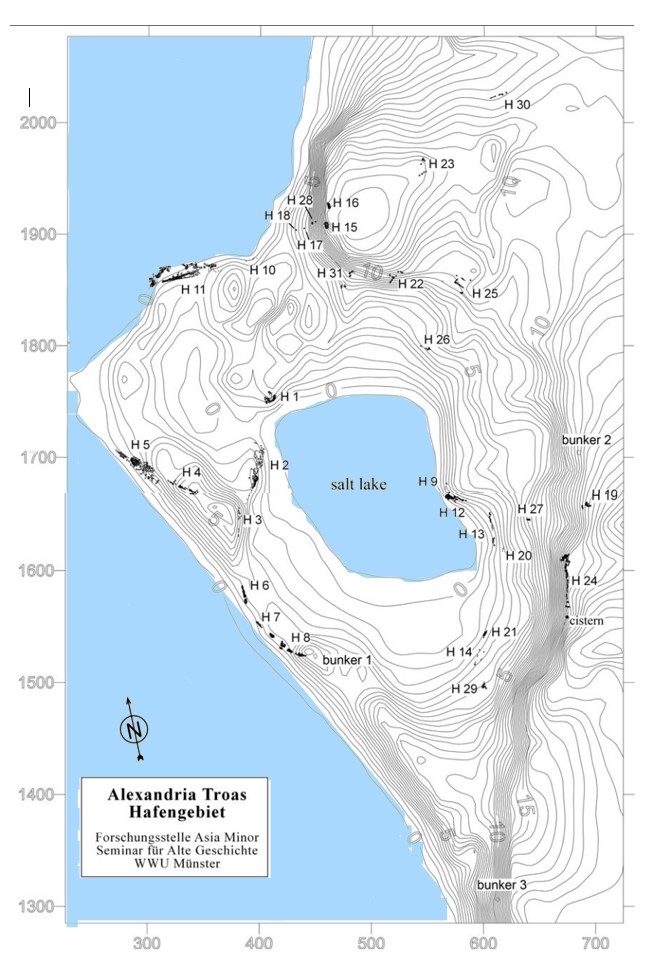
Troas – Ancient Site | No labels | Troas harbor
Assos – Overview | Close-up | Acropolis
Zoom out to “Cities of Paul near the Hellespont”
Zoom way out to Biblical cities of Turkey (Asia Minor)
Zoom way, way out to “Lands of the Eastern Mediterranean”
Paul’s Second Missionary Journey
Paul’s Third Missionary Journey
Troas, also known as Alexandria Troas, lies on the northwestern shore of Asia Minor 30 km south of the ancient Troy, the famous site of the Trojan War as reported in Homer’s Iliad. In the first century CE, it was a busy first-century seaport and Roman colony. It was noted for exporting monolithic granite columns to cities throughout the Mediterranean, and at its height, its population swelled to perhaps 100,000, making it one of the largest cities in Asia Minor.
The Apostle Paul first visited Troas around the year 50 CE near the beginning of his Second Missionary Journey. While at Troas, Paul had a vision of a man pleading with him, “Come over into Macedonia and help us.” Responding to this vision, Paul launched his missionary efforts in the continent of Europe. This is recorded in Acts 16:8-10.
During Paul’s Third Missionary Journey, in about the year 56, Paul returned to Troas because God had opened the door for the gospel to flourish there (2 Cor. 2:12-13). He returned to Troas once again at the close of the Third Journey, around 59, where he broke bread with Christians there and preached until midnight. A young boy nodded off during the prolonged sermon and fell out the window to his death from the third story. Paul raised him from the dead, and then continued speaking until morning (Acts 20:7-12).
After the Emperor Constantine chose Byzantium over Troas as the new capital of the empire (330 CE), the importance of Troas went into steady decline.
Excavations at Troas, ongoing since 1993, are conducted as a collaborative effort between Ankara University, Çanakkale University, and the University of Muenster. Despite the looting of the site in the 17th C. CE down to the foundations of many of its buildings, the archaeological team has uncovered and explored the circular courtyard gate, forum temple, colonnaded street, podium hall, polygonal building, stadium, lower agora, theater, odeum, central baths, nymphaeum, buildings of Herodes Atticus (its 2nd C. CE Athenian benefactor), aqueducts, the sewer system, and the artificial harbor. Professor Erhan Öztepe of Ankara University is the current excavation director.
Want to Dive Deeper?
The following are recommended to help you look deeper into the history and archaeology of Alexandria Troas.
Recommended for purchase:
CD-ROM: Turkey: Pictorial Library of Bible Lands (2004)
Marijana Ricl – The Inscriptions of Alexandria Troas (Österreichische Akademie der Wissenschaften, Habelt, 1997).
Haberin Devami – “Architectural Details of Ancient City Uncovered” (09/20/2019).
Claude E. Fant & Mitchell G. Reddish – A Guide to Biblical Sites in Greece and Turkey (Oxford, 2003). Excerpt
Online resources:
W. J. Conybeare & J. S. Howson – “Life & Epistles of St. Paul (1869).
“Excavations in Çanakkale Alexandria Troas” Artdog Istanbul (10/09/2023)
Stefan Feuser. “The Roman Harbour of Alexandria Troas, Turkey.” International Journal of Nautical Archaeology 40, 2 (2011): 256-273.
C. J. Hemer. “Alexandria Troas.” Tyndale Bulletin 26, 1 (May 10, 1975): 79-112.
Robert Jewett. “The Troas Project: Investigating Maritime and Land Routes to Clarify the Role of Alexandria Troas in Commerce and Religion.” (May 2005)
Grabund in Alexandria Troas (in German, translation: “Excavations in Alexandria Troas”). Institut für Klassische Archäologie und Frühchristliche Archäologie der Westfälischen Wilhelms-Universität Münster.
Gairika Mitra – “Theater discovered at Alexandria Troas” (10/26/2024)
James Strahan – “Troas” (2:620 in Dictionary of the Apostolic Church, ed. James Hastings, et al. London: T. & T. Clark, 1918).
